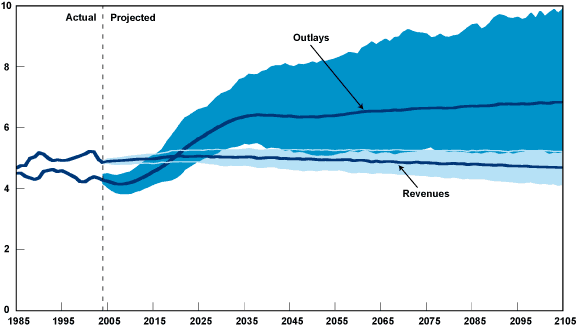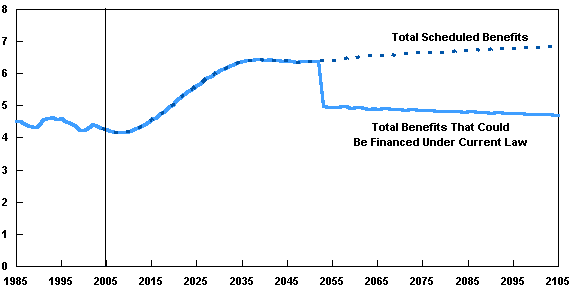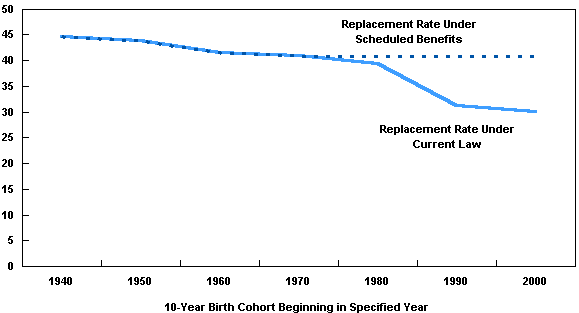|
|
|
Updated Long-Term Projections for Social SecurityMarch 2005The Congressional Budget Office (CBO) most recently released long-term (100-year) Social Security projections in The Outlook for Social Security (June 2004). As a result of both economic and technical revisions, those projections have changed slightly. The attached tables and figures present the updated projections. The Outlook for Social Security presented ranges of uncertainty around the market-value outcomes (previously labeled expected); the attached tables and figures include a complete update of those projections. (In late January, a partial update was posted that included only an update to the market-value projections. All of that material appears in this new update.) CBO presents future Social Security benefits under two scenarios. In one scenario, outlays include only those benefits that the Social Security Administration has legal authority to pay under current law. That scenario assumes that all benefits are reduced annually once the trust funds are exhausted so that total outlays equal available revenues. (In the June report, this current-law scenario was described as the "trust-fund-financed" scenario.) In the second analysis, outlays include the full benefits as currently calculated. That is the "scheduled benefits" scenario. CBO projects that under current law Social Security outlays will first exceed revenues from payroll taxes and taxation of benefits in 2020 and that the program will exhaust the trust funds in 2052. After the trust funds are exhausted, Social Security spending cannot exceed annual revenues. As a consequence, because dedicated revenues are projected to equal 78 percent of scheduled outlays in 2053, CBO projects that the benefits paid will be 22 percent lower than the scheduled benefits. After 2053, the imbalance will widen, CBO projects. Since the last estimates were released, CBO has updated its economic and budget forecast for the next 10 years (see The Budget and Economic Outlook: Fiscal Years 2006 to 2015), incorporated updated Social Security earnings records, and refined the method used to estimate retroactive disability payments. In addition, the modeling of uncertainty has been updated to reflect additional historical data, and uncertainty about another key variable--the share of compensation that will be paid as nontaxable benefits (such as health insurance)--was incorporated. While the major long-term economic assumptions did not change, there were small revisions in the estimated historical values and projected values of hours worked in the economy, as well as the projected differential growth in two measures of prices: the price index for gross domestic product (GDP) and the consumer price index. CBO projects that, over the next 10 years, Social Security outlays will average about 0.2 percentage points lower relative to GDP than was projected last summer, primarily because of an increase in projected GDP. The difference diminishes over the following decade, and CBO projects that, for 2030 to 2050, outlays will average 0.1 percentage points higher as a percentage of GDP than projected last summer. Projected outlays for later years are essentially unchanged. CBO revised its projection of Social Security revenues relative to GDP down slightly. CBO projects that by the end of the 100-year projection period, revenues will be 4.7 percent of GDP, 0.1 percentage point lower than projected last summer. The range of uncertainty about the projections of Social Security revenues has increased since the June 2004 report, reflecting the inclusion of uncertainty about the share of compensation that will be paid as nontaxable benefits in the future. By 2105, the range in projected revenues as a share of GDP has increased three-fold relative to the results presented in June. That increase in uncertainty about revenues does not, however, change the conclusions stated in The Outlook for Social Security about the future of Social Security. Figures 2-4 and 2-5 in The Outlook for Social Security included an inconsistency between the numbers and the footnotes, which said the numbers were discounted to age 60 dollars. They were instead discounted to age 16 dollars. In this update, the numbers have been adjusted to remove the inconsistency.
Social Security Outlays and Revenues as a Share of GDP in Selected Years Under the Scheduled Benefits Scenario, 2003 to 2100
Potential Range of Social Security Outlays and Revenues Under the Scheduled Benefits Scenario (Percentage of GDP)
 Source: Congressional Budget Office.
Summarized Social Security Outlays, Revenues, and Balances Under the Scheduled Benefits Scenario
Potential Range of the OASDI Trust Fund Ratio Under the Scheduled Benefits Scenario, 1985 to 2105  Source: Congressional Budget Office.
Outlays for Benefits Under Current Law and Under the Scheduled Benefit Scenario, 1985 to 2105 (Percentage of GDP)
 Source: Congressional Budget Office.
Median First-Year Retirement Benefits, by Birth Cohort (2004 Dollars)
 Source: Congressional Budget Office.
Median Replacement Rates, by Birth Cohort (Percent)
 Source: Congressional Budget Office.
Median Lifetime Retirement Benefits, by Birth Cohort (Present value in 2004 Dollars)
 Source: Congressional Budget Office.
Measures of the Benefits Received by the Median Retired Worker, by Birth Cohort and Lifetime Earnings Level
Potential Range of Lifetime Payroll Taxes Under Current Law, by Birth Cohort and Lifetime Earnings Level (2004 Dollars)
 Source: Congressional Budget Office.
Potential Range of Lifetime Social Security Benefits to Under Current Law and Under the Scheduled Benefits Scenario, by Birth Cohort and Lifetime Earnings Level (2004 Dollars)
 Source: Congressional Budget Office.
Potential Range of the Ratio of Lifetime Social Security Benefits to Lifetime Taxes Under Current Law and Under the Scheduled Benefits Scenario, by Birth Cohort and Lifetime Earnings Level (In percent)
 Source: Congressional Budget Office.
Measures of the Benefits Received by the Median Retired Worker, by Birth Cohort and Lifetime Earnings Level
|
|||||||||||||||||||||||||||||||||||||||||||||||||||||||||||||||||||||||||||||||||||||||||||||||||||||||||||||||||||||||||||||||||||||||||||||||||||||||||||||||||||||||||||||||||||||||||||||||||||||||||||||||||||||||||||||||||||||||||||||||||||||||||||||||||||||||||||||||||||||||||||||||||||||||||||||||||||||||||||||||||||||||||||||||||||||||||||||||||||||||||||||||||||||||||||||||||||||||||||||||||||||||||||||||||||||||||||||||||||||||||||||||||||||||||||||||||||||||||||||||||||||||||||||||||||||||||||||||||||||||||||||||||||||||||||||||||||||||||||||||||||||||||||||||||||||||||||||||||||||||||||||||||||||||||||||||||||||||||||||||||||||||||||||||||||||||||||||||||||||||||||||||||||||||||||||||||||||||||||||||||||||||||||||||||||||||||||||||||||||||||||||||||||||||||||||||||||||||||||||||||||||||||||||||||||||||||||||||||||||||||||||||||||||||||||||||||||||||||||||||||||||||||||||||||||||||||||||||||||||||||||||||||||||||||||||||||||||||||||||||||||||||||||||||||||||||||||||||||||||||